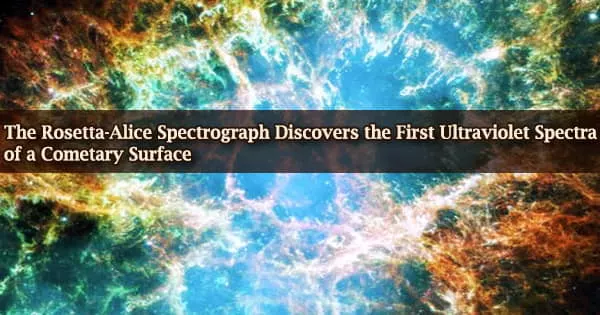The Alice ultraviolet (UV) spectrograph aboard the Rosetta comet spacecraft of the European Space Agency has made its first scientific discoveries. Rosetta is the first spacecraft to examine a comet up close, orbiting comet 67P/Churyumov-Gerasimenko.
Last month, when Alice began mapping the comet’s surface, it produced the first cometary surface far-ultraviolet spectra. The Alice team discovered that the comet is extremely black at ultraviolet wavelengths and that there are no big water-ice patches on the comet’s surface so far. Alice has already detected hydrogen and oxygen in the coma, or atmosphere, of the comet.
“We’re a bit surprised at both just how very unreflective the comet’s surface is, and what little evidence of exposed water-ice it shows,” says Dr. Alan Stern, Alice principal investigator and an associate vice president of the Southwest Research Institute (SwRI) Space Science and Engineering Division.
As the mission progresses, we will continue to search for surface ice patches and ultraviolet color and composition variations across the surface of the comet.
Dr. Lori Feaga
Alice, developed by SwRI, is studying the comet’s origin, composition, and workings, providing delicate, high-resolution compositional insights that neither ground-based nor Earth-orbital studies can provide. Alice’s observations of ultraviolet wavelengths reveal unique information on the composition of the comet’s atmosphere and surface features.
“As the mission progresses, we will continue to search for surface ice patches and ultraviolet color and composition variations across the surface of the comet,” says Dr. Lori Feaga, Alice co-investigator at the University of Maryland.
Alice is one of three NASA-funded experiments aboard Rosetta. Alice weighs less than 4 kilograms and uses only 4 watts of electricity, yet it has 1,000 times the data-gathering potential of devices flown a generation ago.
SwRI created a sister Alice experiment, which was launched aboard the New Horizons spacecraft to Pluto in January 2006 to examine its atmosphere.
In July 2015, it will arrive at Pluto. SwRI also designed and runs Rosetta’s Ion and Electron Spectrograph (IES), a tiny electronic system instrument. IES achieves sensitivity comparable to equipment weighing five times more with a mass of 1.04 kg.
The Rosetta spacecraft used four gravity assistance (three from Earth, one from Mars) and a nearly three-year deep space sleep to reach its comet target, waking up in January 2014 in time for its rendezvous with Churyumov-Gerasimenko.
In November 2014, Rosetta will drop a lander, Philae, to the comet’s surface, attempting the first-ever direct observations of a comet surface.
Rosetta is a European Space Agency (ESA) project funded by member governments and NASA. A consortium coordinated by DLR, MPS, CNES, and ASI is providing Rosetta’s Philae lander. Airbus Defense manufactured the Rosetta spacecraft and Space.
Under a contract with the California Institute of Technology (Caltech), NASA’s Jet Propulsion Laboratory (JPL) administers the US contribution to the Rosetta project for NASA’s Science Mission Directorate in Washington.
JPL also built the Microwave Instrument for the Rosetta Orbiter and hosts its principal investigator, Dr. Samuel Gulkis. SwRI (San Antonio and Boulder, Colo.) developed the Rosetta orbiter’s Ion and Electron Sensor and Alice instrument and hosts their principal investigators, Dr. James Burch (IES) and Dr. Alan Stern (Alice).





